|
This is Jak Kirman's (self described) "A modest STL
tutorial". This page was rescued from
http://tux.cs.brown.edu/people/jak/proglang/cpp/stltut
It has been archived
here because two other copies of it on the web were
falling into disrepair.
This is the entire document.
The only changes that have been made are to add these
comments, to compress some of the larger GIF files,
to remove dead links and to remove the links that allowed
the user to download a gzip, zip or tar-ed version of
this page (why download those files when you can just
point your browser at this page?).
This document is specifically
NOT copyrighted by The Database Managers, Inc.
This document belongs to Jak Kirman and its use on this
web site is within the terms and conditions outlined
by Mr. Kirman in his preamble (below). The Database
Managers, Inc. certifies that nobody from our company
has made any changes other than those outlined in these
comments.
Go Back to CPP Programming Resources
A modest STL tutorial
I am using a software tool called hyperlatex
[this used to link to http://www.cs.ruu.nl/people/otfried/html/hyperlatex_1.html
but this is now a dead link] to create this document.
The tutorial is also available in gzip-compressed postscript
form or zip-compressed postscript form. For those wanting
to install a copy of these pages on their system, they
may be freely copied providing they are not modified
in any significant way (other than, say, locale changes).
The file tut.tar.Z contains a tarred distribution of
the pages. Please note that I will be making modifications
to this document in the coming months, so you may want
to occasionally check for changes. I will start putting
in version numbers, and if I can manage to, changebars.
Disclaimer
I started looking at STL in 1995; for a long time I
could compile only minimal subsets of the HP version
of the library. More recently, the compilers used by
the students I teach have been able to support more
of STL, and I have been adding it to the introductory
and advanced courses I teach. Now, at the beginning
of 1998, I use STL in the labs for all of the courses
I teach.
I have been using C++ since 1988, and teaching C++
and object-oriented design courses in industry since
1990. I really like the design philosophies in STL;
I think that you can learn a great deal about how generalization
can simplify programming by understanding why STL is
constructed the way it is.
Mark Nelson's book on STL is very good if you want
to understand the internal details, but is probably
overkill for many people. Musser and Saini have a good
book on STL, but it is a bit out-of-date.
I haven't seen very much online documentation on STL,
apart from the good but rather dense paper by Stepanov
and Lee, I thought I would try to write something to
give people a taste of what a good library will be do
for them.
Another reason for getting people to start trying out
STL soon is to put pressure on the compiler-writers
to get their compilers patched up enough to take the
strain it puts on them...
I would greatly appreciate comments or suggestions
from anyone.
Outline
STL contains five kinds of components: containers,
iterators, algorithms, function objects and allocators.
In the section Example I present
a simple example, introducing each of the five categories
of STL components one at a time.
In the section Philosophy I explain
the rationale behind the organization of STL, and give
some hints on the best ways to use it. (Not yet written)
The Components section goes into
each category of component in more detail.
The section Extending STL shows how
to define your own types to satisfy the STL requirements.
(Not yet written)
A first example
Most of you probably use some kind of auto-allocating
array-like type. STL has one called vector.
To illustrate how
vector
works, we will start with a simple C++ program that
reads integers, sorts them, and prints them out. We
will gradually replace bits of this program with STL
calls.
Version 1: Standard C++
Here is a standard C++ program to read a list of integers,
sort them and print them:
#include <stdlib.h>
#include <iostream.h>
// a and b point to integers. cmp returns -1 if
a is less than b,
// 0 if they are equal, and 1 if a is greater than b.
inline int cmp (const void *a, const void *b)
{
int aa = *(int *)a;
int bb = *(int *)b;
return (aa < bb) ? -1 : (aa > bb) ? 1 :
0;
}
// Read a list of integers from stdin
// Sort (c library qsort)
// Print the list
main (int argc, char *argv[])
{
const int size = 1000; // array of 1000
integers
int array [size];
int n = 0;
// read an integer into the n+1 th element of
array
while (cin >> array[n++]);
n--; // it got incremented once too many times
qsort (array, n, sizeof(int), cmp);
for (int i = 0; i < n; i++)
cout << array[i] << "\n";
}
Version
2: containers, iterators, algorithms
STL provides a number of container types,
representing objects that contain other objects. One
of these containers is a class called vector
that behaves like an array,
but can grow itself as necessary. One of the operations
on vector
is push_back,
which pushes an element onto the end of the vector
(growing it by one).
A vector contains a block of contiguous initialized
elements -- if element index k has been initialized,
then so have all the ones with indices less than k.
A vector can be presized, supplying the size at construction,
and you can ask a vector how many elements it has with
size.
This is the logical number of elements -- the
number of elements up to the highest-indexed one you
have used. There is a also a notion of capacity
-- the number of elements the vector can hold before
reallocating.
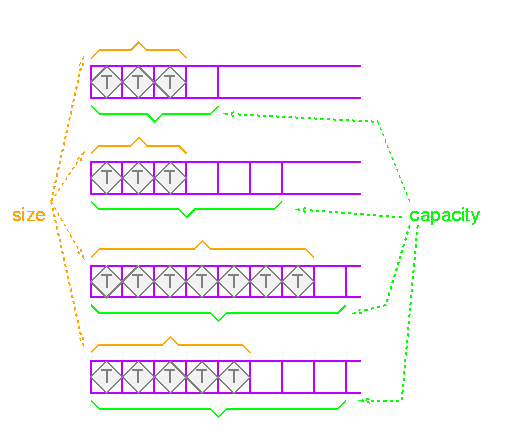
Let's read the elements and push them onto the end
of a vector. This removes the arbitrary limit on the
number of elements that can be read.
Also, instead of using qsort, we will use the STL sort
routine, one of the many algorithms
provided by STL. The sort routine is generic, in that
it will work on many different types of containers.
The way this is done is by having algorithms deal not
with containers directly, but with iterators.
Preview of iterators
I'll go into iterators in detail later, but for now
here is enough to get started.
Iterators provide a way of specifying a position in
a container. An iterator can be incremented or dereferenced,
and two iterators can be compared. There is a special
iterator value called "past-the-end".
You can ask a vector for an iterator that points to
the first element with the message begin. You can get a past-the-end
iterator with the message end. The code
vector<int> v;
// add some integers to v
vector::iterator i1 = v.begin();
vector::iterator i2 = v.end();
will create two iterators like this:

Operations like sort take two iterators to specify
the source range. To get the source elements, they increment
and dereference the first iterator until it is equal
to the second iterator. Note that this is a semi-open
range: it includes the start but not the end.
Two vector iterators compare equal if they refer to
the same element of the same vector.
Putting this together, here is the new program:
#include <string.h>
#include <algo.h>
#include <vector.h>
#include <stdlib.h>
#include <iostream.h>
main ()
{
vector<int> v; // create an empty
vector of integers
int input;
while (cin >> input)
// while not end of file
v.push_back (input); // append
to vector
// sort takes two random iterators, and sorts
the elements between
// them. As is always the case in STL,
this includes the value
// referred to by first but not the one referred
to by last; indeed,
// this is often the past-the-end value, and
is therefore not
// dereferenceable.
sort(v.begin(), v.end());
int n = v.size();
for (int i = 0; i < n; i++)
cout << v[i] << "\n";
}
Incidentally, this is much faster than qsort; at least
a factor of 20 on the examples I tried. This is presumably
due to the fact that comparisons are done inline.
Version 3: iterator adaptors
In addition to iterating through containers, iterators
can iterate over streams, either to read elements or
to write them.
An input stream like cin has
the right functionality for an input iterator:
it provides access to a sequence of elements. The trouble
is, it has the wrong interface for an iterator:
operations that use iterators expect to be able to increment
them and dereference them.
STL provides adaptors, types that transform
the interface of other types. This is very much how
electrical adaptors work. One very useful adaptor is
istream_iterator.
This is a template type (of course!); you parameterize
it by the type of object you want to read from the stream.
In this case we want integers, so we would use an istream_iterator<int>.
Istream iterators are initialized by giving them
a stream, and thereafter, dereferencing the iterator
reads an element from the stream, and incrementing the
iterator has no effect. An istream iterator that is
created with the default constructor has the past-the-end
value, as does an iterator whose stream has reached
the end of file.
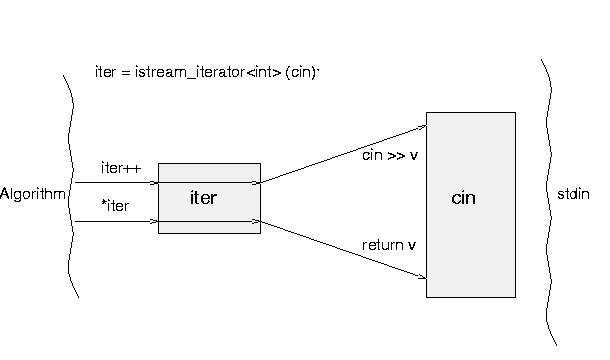
In order to read the elements into the vector from
standard input, we will use the STL copy algorithm; this
takes three iterators. The first two specify the source
range, and the third specifies the destination.
The names can get pretty messy, so make good use of
typedefs. Iterators are actually parameterized on two
types; the second is a distance type, which I believe
is really of use only on operating systems with multiple
memory models. Here is a typedef for an iterator that
will read from a stream of integers:
typedef istream_iterator<int,ptrdiff_t> istream_iterator_int;
The second argument to the template should default
to ptrdiff_t, but most compilers do not understand default
template arguments. Some implementations of STL define
istream_iterators with
only one parameter, and supply a hard-coded distance
type. So you will have to see whether your compiler
understands default template arguments; if it does,
you can declare the iterator type like this:
typedef istream_iterator<int> istream_iterator_int;
So to copy from standard input into a vector, we can
do this:
copy (istream_iterator_int (cin), istream_iterator_int
(), v.begin());
The first iterator will be incremented and read from
until it is equal to the second iterator. The second
iterator is just created with the default constructor;
this gives it the past-the-end value. The first iterator
will also have this value when the end of the stream
is reached. Therefore the range specified by these two
iterators is from the current position in the input
stream to the end of the stream.
There is a bit of a problem with the third iterator,
though: if v does not have enough space to hold all
the elements, the iterator will run off the end, and
we will dereference a past-the-end iterator (which will
cause a segfault).
What we really want is an iterator that will do insertion
rather than overwriting. There is an adaptor to do this,
called back_insert_iterator
. This type is parameterized by the container type you
want to insert into.
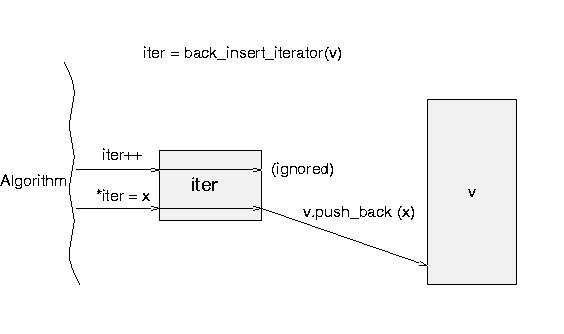
So input is done like this:
typedef istream_iterator<int,ptrdiff_t>
istream_iterator_int;
vector<int> v;
istream_iterator_int start (cin);
istream_iterator_int end;
back_insert_iterator<vector<int> >
dest (v);
copy (start, end, dest);
Similarly, to print out the values after sorting, we
use copy:
copy (v.begin(), v.end(), ostream_iterator<int>
(cout, "\n"));
ostream_iterator is another adaptor; it provides output
iterator functionality: assigning to the dereferenced
iterator will write the data out. The ostream_iterator
constructor takes two arguments: the stream to use and
the separator. It prints the separator between elements.
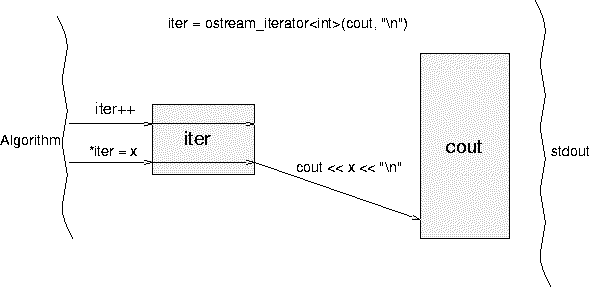
Putting this all together,
#include <string.h>
#include <algo.h>
#include <vector.h>
#include <stdlib.h>
#include <iostream.h>
main ()
{
vector<int> v;
istream_iterator<int,ptrdiff_t> start (cin);
istream_iterator<int,ptrdiff_t> end;
back_insert_iterator<vector<int> >
dest (v);
copy (start, end, dest);
sort(v.begin(), v.end());
copy (v.begin(), v.end(), ostream_iterator<int>(cout,
"\n"));
}
Discussion
I find the final version of the program the cleanest,
because it reflects the way I think of the computation
happening: the vector is copied into memory, sorted,
and copied out again.
In general, in STL, operations are done on containers
as a whole, rather than iterating through the elements
of the container explicitly in a loop. One obvious advantage
of this is that it lends itself easily to parallelization
or hairy optimizations (e.g., one could be clever about
the order the elements were accessed in to help avoid
thrashing).
Most of the STL algorithms apply to ranges of
elements in a container, rather than to the container
as a whole. While this is obviously more general than
having operations always apply to the entire container,
it makes for slightly clumsy syntax. Some implementations
of STL (e.g., ObjectSpace), provide supplementary versions
of the algorithms for common cases. For example, STL
has an algorithm count that counts the
number of times a particular element appears in a container:
template <class InputIterator, class T, class
Size>
void count (InputIterator start, InputIterator end,
const T& value, Size& n);
To find how many elements have the value 42 in a vector
v,
you would write:
int n = 0;
count (v.begin(), v.end(), 42, n);
ObjectSpace defines an algorithm os_count
that provides a simpler interface:
int n = os_count (v, 42);
Philosophy
The Standard Template Library is designed for use with
a style of programming called generic programming
[this originally was a link to www.cs.rpi.edu/musser/gp/
but it is no longer valid]. The essential idea
behind generic programming is to create components that
can be composed easily without losing any performance.
In some sense, it moves the effort that is done at run-time
in object-oriented programming (dynamic binding) to
compile-time, using templates.
STL components
Containers
Containers are objects that conceptually contain other
objects. They use certain basic properties of the objects
(ability to copy, etc.) but otherwise do not depend
on the type of object they contain.
STL containers may contain pointers to objects, though
in this case you will need to do a little extra work.
vectors, lists, deques, sets, multisets, maps, multimaps,
queues, stacks, and priority queues, did I miss any?
are all provided.
Perhaps more importantly, built-in containers (C arrays)
and user-defined containers can also be used as STL
containers; this is generally useful when applying operations
to the containers, e.g., sorting a container. Using
user-defined types as STL containers can be accomplished
by satisfying the requirements listed in the STL container
requirements definition.
If this is not feasible, you can define an adaptor
class that changes the interface to satisfy the
requirements.
All the types are "templated", of course,
so you can have a vector of ints or Windows or a vector
of vector of sets of multimaps of strings to Students.
Sweat, compiler-writers, sweat!
To give you a brief idea of the containers that are
available, here is the hierarchy:
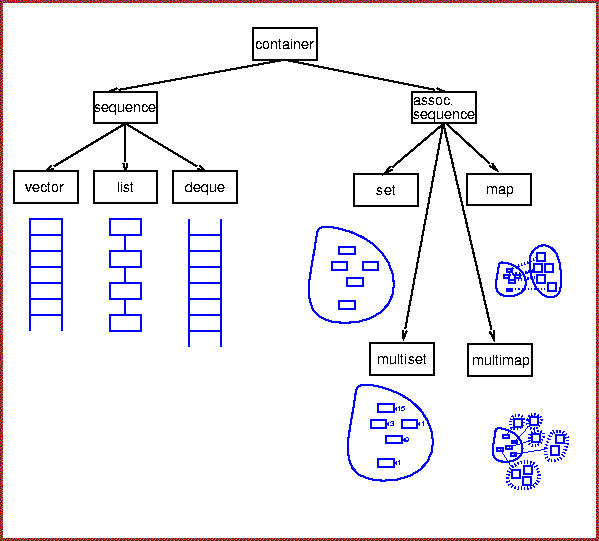
Sequences
Contiguous blocks of objects; you can insert elements
at any point in the sequence, but the performance will
depend on the type of sequence and where you are inserting.
Vectors
Fast insertion at end, and allow random access.
Lists
Fast insertion anywhere, but provide only sequential
access.
Deques
Fast insertion at either end, and allow random access.
Restricted types, such as stack and queue, are built
from these using adaptors.
Stacks and queues
Provide restricted versions of these types, in which
some operations are not allowed.
Associative containers
Associative containers are a generalization of sequences.
Sequences are indexed by integers; associative containers
can be indexed by any type.
The most common type to use as a key is a string; you
can have a set of strings, or a map from strings to
employees, and so forth.
It is often useful to have other types as keys; for
example, if I want to keep track of the names of all
the Widgets in an application, I could use a map from
Widgets to Strings.
Sets
Sets allow you to add and delete elements, query for
membership, and iterate through the set.
Multisets
Multisets are just like sets, except that you can
have several copies of the same element (these are often
called bags).
Maps
Maps represent a mapping from one type (the key
type) to another type (the value type). You can
associate a value with a key, or find the value associated
with a key, very efficiently; you can also iterate through
all the keys.
Multimaps
Multimaps are just like maps except that a key can
be associated with several values.
Should add other containers: priority queue, bit
vector, queue.
Examples using containers
Here is a program that generates a random permutation
of the first n
integers, where n
is specified on the command line.
#include <iostream.h>
#include <vector.h>
#include <algo.h>
#include <iterator.h>
main (int argc, char *argv[])
{
int n = atoi (argv[1]); // argument checking
removed for clarity
vector<int> v;
for (int i = 0; i < n; i++)
// append integers 0 to n-1 to v
v.push_back (i);
random_shuffle (v.begin(), v.end());
// shuffle
copy (v.begin(), v.end(), ostream_iterator<int>
(cout, "\n")); // print
}
This program creates an empty vector and fills it with
the integers from 0 to
n. It then shuffles
the vector and prints it out.
It is quite common to want a sequence of elements with
arithmetically increasing values; common enough that
there is an algorithm that does something like this
for us. It is called iota:
template <class ForwardIterator, class T>
void iota (ForwardIterator first, ForwardIterator last,
T value);
This function allows us to fill a range of a container
with increasing values, starting with some initial value:
vector<int> a(100); // initial size 100
iota (a.begin(), a.end(), 0);
This call will fill the array a
with the values 0, 1, 2...
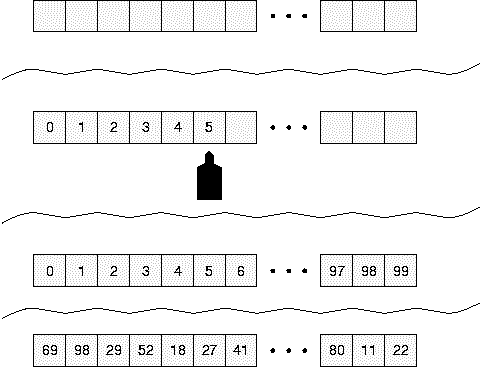
Unfortunately, this is not quite what we wanted --
this overwrites an existing vector, whereas in our case,
we had an empty vector, and we wanted the elements appended
to it. There are two problems here. The first is that
the termination condition for the iota
function is specified by an iterator; the
loop terminates when the moving iterator becomes equal
to the terminal iterator.
Many algorithms in STL come in several flavors, corresponding
to different terminating conditions. For example, generate
uses two iterators to specify a range; generate_n
uses one iterator and an integer to specify the range.
The iota
function, unfortunately,
does not have an
iota_n counterpart,
but it is very easy to write:
template <class ForwardIterator, class T>
void iota_n (ForwardIterator first, int n, T value)
{
for (int i = 0; i < n; i++)
*first++ = value++;
}
In order to append to the vector instead of overwriting
its contents, we will use an adaptor
back_inserter:
#include <iostream.h>
#include <vector.h>
#include <algo.h>
#include <iterator.h>
main (int argc, char *argv[])
{
int n = atoi (argv[1]); // argument checking
removed for clarity
vector<int> v;
iota_n (v.begin(), 100, back_inserter(v));
random_shuffle (v.begin(), v.end());
// shuffle
copy (v.begin(), v.end(), ostream_iterator<int>
(cout, "\n")); // print
}
back_inserter
is a function that takes a container as
an argument, and returns an iterator. The iterator is
defined in such a way that writing a value through it
and incrementing it will cause the value to be appended
to the container.
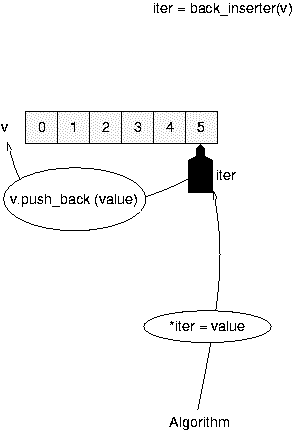
Iterators
Iterators are like location specifiers for containers
or streams of data, in the same way that an int*
can be used as a
location specifier for an array of integers, or an ifstream
can be used as a location specifier for a file. STL
provides a variety of iterators for its different collection
types and for streams.
Input iterators
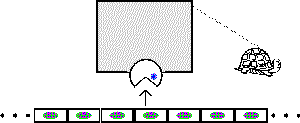
Input iterators provide access to data sources. The
source may be an STL container, another type of container,
a stream, a virtual source (such as a set of permutations),
etc.
Output iterators
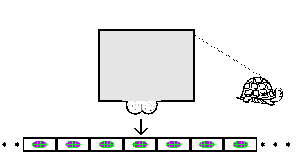
Output iterators provide access to data sinks: locations
to store the results of a computation. The sink may
be an STL container, a user-defined container, a stream,
etc.
Using input and output iterators
Just input and output iterators are enough to do quite
a lot, since many operations boil down to copying objects
around. For example, this function copies all the elements
of a container v to standard output. ostream_iterator
is an adaptor; it is an output
iterator type. The iterator operations are defined so
that in the case below, assigning through the iterator
prints to standard output, with each print followed
by a newline.
copy (v.begin(), v.end(), ostream_iterator<int>
(cout, "\\n"));
The first two arguments specify the source data: start
an iterator that points to the beginning of the vector
v, and keep going until the iterator compares equal
with v.end(), which is called a past-the-end value.
Almost all STL operations have one or more pairs of
input iterators specifying the data to work with.
The third argument is an adaptor that turns an ostream
like cout into an output iterator; don't worry about
the details for now.
A similar operation reads data into a vector (for now,
we will assume the vector has enough space allocated
already):
copy (istream_iterator<int> (cin), istream_iterator<int>
(), v.begin());
Moreover, input and output iterators are necessary
to do many things, since we usually need to specify
what data we want to work with, and where to put the
result.
Forward iterators
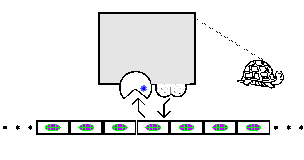
A forward iterator allows traversal of the sequence,
reading and/or writing each element, but no backing
up. Many algorithms request a forward iterator, for
example
long *p = new int [1000];
fill (p, p+100, 0);
fill (p+101, p+1000, 0xDeadBeef);
Fill's first two arguments specify the range the operation
should take place on, and the third specifies the value
to write through the iterator at each position.
Bidirectional iterators
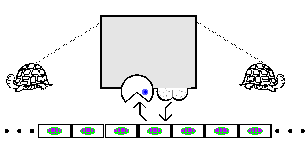
Bidirectional iterators can be moved forward or backward,
and can be used to read or write the elements of the
sequence. Moving an iterator from one part of the sequence
to another takes time proportional to the number of
elements between the two.
Containers and iterators
All the STL containers provide at least bidirectional
iterators: lists, sets, maps, and so on can be traversed
forward or backward. Some containers provide even more
flexible indexing:
Random access iterators
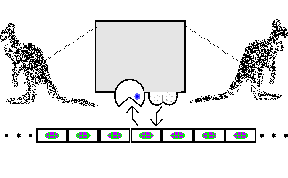
Random access iterators can jump from any place to
any other place in constant time I am not sure that
this is required, and it is certainly allowed to be
amortized constant time. Every C pointer type is
an STL random iterator for a C array container. If you
have a random-access container, you can perform all
sorts of nifty operations on it, such as mapping over
a vector, with or without accumulation, finding and
replacing elements satisfying predicates, partitions,
shuffling, and many more. The extent of this library
never ceases to amaze me given that the source code
is really quite small. I think that is a testimony to
this kind of generic programming.
Algorithms
The STL algorithms are template C++ functions to perform
operations on containers. In order to be able to work
with many different types of containers, the algorithms
do not take containers as arguments. Instead, they take
iterators that specify part or all of a container. In
this way the algorithms can be used to work on entities
that are not containers; for example, the function copy can be used to
copy data from standard input into a vector.
Some algorithms require only the capabilities of input
iterators, while others require random access (e.g.,
to sort).
The algorithms include sorting operations (sort, merge,
min, max...), searching operations (find, count, equal...),
mutating operations (transform, replace, fill, rotate,
shuffle...), and generalized numeric operations (accumulate,
adjacent difference...).
Function
objects
Function objects are STL's way of representing "executable
data". For example, one of the STL algorithms is
for_each
. This applies a function to each object in a container.
You need to be able to specify what to do to
each object in the container.
Overview
Function objects are objects on which at least one
parenthesis operation (.
. .) is defined. They
are used for three main purposes: generating data, testing
data (predicates), and applying operations.
Generators
Algorithms like generate
walk through a range, calling a function object
at each step, and assigning the result of the function
to the current element.
[picture]
For example, here is a function that always returns
0:
int zero() { return 0; }
To fill a vector with zeroes, one could use the algorithm
generate
with the function object zero:
vector<int> v (100);
generate (v.begin(), v.end(), zero);
Of course, it would be nice if our function were a
bit more widely useful -- for example, allowing an arbitrary
arithmetic sequence. In order to do this, the function
object has to store some state indicating where in the
sequence it is. There are two ways to do this. One is
to use static variables inside a global function, the
other is to define a class of function objects.
[In an aside] There are several problems with using
static variables in a function to store state. There
can only be one position remembered in the sequence
-- copies of the function object will all always be
positioned at the same point in the sequence. [Other
problems?]
Here is a class Iota . It provides an arithmetic
sequence, starting with some initial value, and repeatedly
adding an increment to it. The function call operator
returns the current value and moves on to the next element
of the sequence. The template is defined with two types
S and T. Usually these will be the
same, but they might be different, e.g., Date
and int . It is usually a good idea to ask
yourself if there is some straightforward generalization
of what you are about to do -- if it doesn't make things
much more complicated, it is probably worth it.
template <class S, class T>
class Iota
{
S cur;
T inc;
public:
Iota (const S& initial, const
T& increment)
: cur (initial), inc (increment)
{ }
S operator()() { S tmp (cur); cur
+= inc; return tmp; }
};
Requirements: if a is an instance of the type
S, and b is an instance of the type T, the following
expressions must be valid:
S a (b)
a += b
This template class can be used with any types S
and T
that satisfy the requirements; for example, if both
S
and T
are
int, the requirements
are satisfied:
vector<int> v (365);
generate (v.begin(), v.end(), Iota<int,int> (0,
1));
cout << v << endl;
It is a bit tedious to have to keep specifying the
types of the arguments; you might hope that the compiler
could figure them out from the expressions provided.
Unfortunately, you can't create an instance of a template
class without providing the types, but you can
use a function to help out, and get the same effect:
template <class S, class T>
Iota<S, T> makeIota (const S& s, const T&
t)
{
return Iota<S, T> (s, t);
}
And now the user code becomes:
vector<int> v (365);
generate (v.begin(), v.end(), makeIota (0, 1));
cout << v << endl;
Here, the function object is storing some state between
calls; it is what is called a closure in some
languages. Anything needed to initialize the data is
provided in the construction of the function object.
Predicates
The second type of function object is used to test
things; the parenthesis operator will be defined to
return something that can be tested for truth. find_if
uses a function object to test each element of a range,
returning an iterator pointing to the first element
that satisfies the test. In this case, the function
object takes an argument, the element of the range,
and returns a boolean:
bool
greaterThanZero (int i) return i > 0;
This could be used to move to the first strictly positive
element of a range:
typedef vector<int>::iterator iterator;
typedef vector<int> vector;
typedef ostream_iterator<int> output;
vector v;
iterator iter = find_if (v.begin(), v.end(), greaterThanZero);
if (iter == v.end())
cout << "no elements greater than
zero" << endl;
else
{
cout << "elements starting
from first greater than zero: ";
copy (iter, v.end(), output (cout,
" "));
}
Again, it is often useful to be able to provide state
in the predicate object. Here is a predicate that tests
true if the element is within a specified range:
class InRange
{
const T& low;
const T& high;
public:
InRange (const T& l, const T&
h) : low (l), high (h) { }
bool operator()(const T& t) {
return ! (t < l) && t < h; }
};
Here we find, and print, all the elements of a vector
that fall within a particular range:
typedef vector<int>::iterator iterator;
typedef vector<int> vector;
typedef ostream_iterator<int> output;
vector v (100);
generate (v.begin(), v.end(), rand);
iterator iter (v);
while (iter != v.end())
{
iter = find (v.begin(), v.end(), InRange (0,
10000));
cout << *iter << endl;
}
It is possible to simulate lexical scoping.
There are many pre-defined (templated, of course)
function objects that can be used -- many algorithms
expect a function as an argument.
example
Adaptors
Sometimes you have a class that does the right thing,
but has the wrong interface for your purposes. Adaptors
are classes that sit between you and another class,
and translate the messages you want to send into the
messages the other class wants to receive.
For example, the copy
function expects an
input iterator to get its data from. The istream
class has the right
functionality: it acts as a source of data, but it has
the wrong interface: it uses <<
etc.
There is an adaptor called istream_iterator
that provides the interface that copy
expects, translating requests into
istream operations.
Other adaptors provide backward-moving iterators from
forward-moving iterators, and queues from lists, for
example.
Adaptors are very useful, but you don't have to understand
them to use STL; treat them as black magic for now.
Allocators
I confess I don't really understand STL's allocation
model properly yet, so I won't say anything about this
for now. You don't need to know anything about them
for now either.
Extending STL
Examples
Iterators
The STL iterator model is somewhat different from most
iterators I have seen. Most importantly, it is very
flexible in regards to the type of thing iterators are
ranging over. Containers are conceptually grouped by
the type of access iterators can provide to them, and
iterations on any random access container (for
example) is done the same way -- the object doing the
iteration does not know what kind of container it is.
The other important difference is that whereas many
iterator mechanisms are mainly intended for iteration
over the entire collection, STL always deals in terms
of ranges, though of course the entire collection is
just a particular range.
Be careful not to confuse the past-the-end iterator
value with the "null" value that other iterator
types often provide to indicate the end of the container.
In particular, don't use the past-the-end iterator to
indicate an error; if you want to indicate errors, you
should provide singular iterator values; I will
describe these in the section on iterators.
Example 2: Finding scheduling conflicts
There is just a sketch of the problem and solution
here. Students are associated with a list of courses,
and courses with a list of timeslots. We want to know
which students have different courses with same timeslot.
Uses:
- algorithms: copy, find
- iterators: istream_iterator, ostream_iterator
- adaptors: istream_iterator, ostream_iterator
- containers: multiset, set
Problem
I have a file of information about students, of the
form:
name [course...]
...
and a file of information about courses, of the form:
course [timeslot...]
...
The names, courses and timeslots are arbitrary strings,
but for simplicity we will assume that each token is
one word (e.g., we write student names like Jak_Kirman.
The program must print out the names of students who
have collisions in their course schedules, along with
the courses causing the collisions. Repetitions in the
lists of courses or lists of timeslots should be ignored.
Example 3: Stream
calculator
There is just a sketch of the problem and solution
here. I want to give my program command-line expressions
in Reverse Polish Notation, like a
b + to mean (a+b).
The elements of expressions can be constants or filenames.
The program should repeatedly evaluate the expression,
replacing any occurrence of a file name with the next
number read from that file.
As an added bonus, the types we define will allow
us to combine arbitrary streams of input with arbitrary
operations.
- algorithms: copy, find
- iterators: input_iterator, istream_iterator, ostream_iterator
- functions: binary_function, unary_function
- adaptors: istream_iterator, ostream_iterator
- containers: stack, vector
Problem
I want a program that will let me perform arithmetic
operations on streams of numbers, with each stream coming
from a different file. So as not to complicate the example
with parsing, I will use reverse Polish notation, e.g.,
2
cost1 * 3 cost2 * + 5 /.
The calculator has an internal stack. The expression
is read left to right; if we find a number, we push
it onto the stack. If we find a name, we read a number
from that file and push it onto the stack. If we find
an operator, we apply it, popping elements off the stack
as arguments. The above expression computes ((2
* cost1) + (3 * cost2))/5.
Sketch of design
I will have a stack of input_iterators:
template <class T>
typedef input_iterator<T> *input_iterator_p;
template <class T>
typedef stack<vector<input_iterator_p<T>
> > input_stack;
As each token is read from the command line, we create
an iterator, using the stack as the source of any arguments.
At the end, the stack should have a single iterator,
which we can then copy to the output stream. The only
tricky part here is the "dynamic inheritance".
I will have a kind of input_iterator
called constant_source, for which
- increment does nothing
- dereference returns the constant
template <class T, class Distance> // default
Distance = ptrdiff_t
class constant_source : public input_iterator<T,Distance>
{
private:
const T& value;
bool bad;
public:
friend bool operator==(const number_source<T,
Distance>& x,
const number_source<T, Distance>& y)
{ return x.bad == y.bad; }
number_source() : bad (true) {}
number_source (const T& t) : value (t), bad
(false){} number_source<T,Distance>&
operator++(int = 0) { return *this; }
const T& operator*() const { return value;
}
};
A combiner input iterator is created from two input
iterators s1
and s2,
and a function object func
of type binary_function<T,T,T>.
increment
increments s1
and s2
dereference
dereferences s1
and s2,
applies func
and returns the result
template <class T, class Distance> // default
Distance = ptrdiff_t
class combiner : public input_iterator<T,Distance>
{
protected:
void read() { ++source1; ++source2; value = func
(*source1, *source2); }
friend bool operator==(const combiner<T, Distance>&
x,
const combiner<T, Distance>& y)
{ return (x.source1 == source1) && (y.source1
== source2); }
combiner() : source1(), source2() {}
combiner (input_iterator<T,Distance>&
s1,
input_iterator<T,Distance>& s2,
binary_function<T,T,T> f) : source1 (s1), source2
(s2), func (f)
combiner<T,Distance>& operator++()
{ read(); return *this; }
combiner<T,Distance>& operator++(int)
{ combiner<T,Distance>&
tmp = *this; read(); return tmp;
const T& operator*() const { return value;
}
};
Now, for example, to read pairs from file1
and file2
and print their sums:
main (int argc, char *argv[])
{
combiner<double> adder (istream_iterator<double>(ifstream
(argv[1])),
istream_iterator<double>(ifstream (argv[2])),
plus<double>);
copy (adder, combiner<double>(), ostream_iterator<double>(cout));
}
Appendices
Lambda expressions
Suppose we want to apply a function to all the elements
of a vector. We can define the function locally, since
it is a type definition. It can take any context it
needs in the constructor, and store it internally.
This is not as elegant as lisp or perl's lexical scoping,
but it is better than nothing.
function addOffset(vector<int>& v, int
n)
{
// we want to add n to each element of v
struct AddN : public unary_function<int>
{ AddN(int n) : _n (n) {};
int operator() (const
int& k) { return k + n; }
};
transform (v.begin(), v.end(), v.begin(), AddN(n));
}
Null iterator values
Why doesn't STL have null iterator values? STL iterators
are supposed to be generalized pointers, right? That
phrase has been bandied about a great deal, but it is
very misleading. STL iterators are generalizations of
array pointers, that is, a pointer set to point
into an array, and then incremented or decremented.
It does not make sense to talk about such a pointer
having a null value.
In C and C++, null pointers are used to indicate errors,
or abnormal conditions. When you have a C++ iterator
type, there is normally only one kind of error value
it will return: one indicating "I fell off the
end of the list". It is natural, therefore, for
most iterator classes to use null as the "past-the-end"
value. If you find yourself wanting a null STL iterator,
you probably want the past-the-end value.
Alice vs Humpty const
In "Alice Through the Looking Glass", Alice
meets Humpty Dumpty, and they have a discussion during
which Humpty uses a word to mean something completely
different from its usual meaning. Alice protests that
that was not what the word meant; words mean what the
dictionary says. Humpty says that words mean what he
wants them to mean; he pays them enough.
Courtesy of Eric Anderson and J Coleman, here is the
section, taken from the
text at Indiana University
`When _I_ use a word,' Humpty Dumpty said
in rather a scornful
tone, `it means just what I choose it to mean -- neither
more nor
less.'
`The question is,' said Alice, `whether you CAN
make words mean
so many different things.'
`The question is,' said Humpty Dumpty,
`which is to be master -
- that's all.'
Alice const is the "dictionary" const, or
language definition const, which says that a member
function is constant if and only if the member function
does not modify any of the data members.
Humpty const is the "conceptual" const,
or design const, which says that the object has the
same appearance to the user after the operation as before,
and that it is ok to apply the operation to objects
that must not be modified.
In a String class,
class String
{
private:
char *_data;
mutable int _len;
public:
String (const char *data) : _data
(data), _len (-1) { }
void capitalize() { char *p = _data;
while (*p) *p = toupper(*p++); }
int length() const { if (_len ==
-1) _len = strlen (_data); return _len; }
};
capitalize is Alice const (the value of the pointer
doesn't change), but not Humpty const -- to the user
it seems like a mutating function, and it should not
be applied to objects that are constant.
length is Humpty const (the user thinks of it as an
operation that does not modify the string, and it can
be applied to constant strings), but not Alice const,
since _len changes. The keyword mutable allows you to
change a variable so specified in a const member function.
jak@cs.brown.edu
Popular C++ topics at The Database Managers:
|



